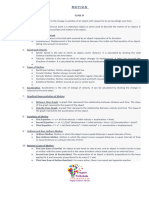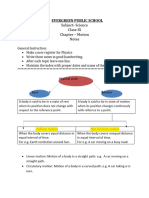0% found this document useful (0 votes)
7 views2 pagesClass9 Physics Motion Notes
The document provides comprehensive notes on motion, defining it as a change in position over time, and categorizing it into types such as rectilinear, circular, and periodic motion. It explains key concepts like distance vs. displacement, speed vs. velocity, and acceleration, along with equations of uniformly accelerated motion. Additionally, it includes important and very important questions for Class 9 students to test their understanding of the topic.
Uploaded by
geetarora1982Copyright
© © All Rights Reserved
We take content rights seriously. If you suspect this is your content, claim it here.
Available Formats
Download as PDF, TXT or read online on Scribd
0% found this document useful (0 votes)
7 views2 pagesClass9 Physics Motion Notes
The document provides comprehensive notes on motion, defining it as a change in position over time, and categorizing it into types such as rectilinear, circular, and periodic motion. It explains key concepts like distance vs. displacement, speed vs. velocity, and acceleration, along with equations of uniformly accelerated motion. Additionally, it includes important and very important questions for Class 9 students to test their understanding of the topic.
Uploaded by
geetarora1982Copyright
© © All Rights Reserved
We take content rights seriously. If you suspect this is your content, claim it here.
Available Formats
Download as PDF, TXT or read online on Scribd
/ 2























































